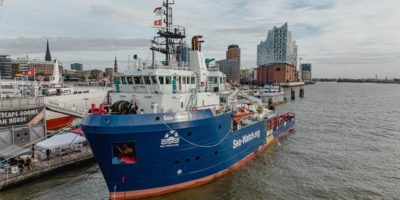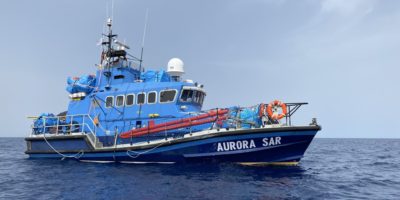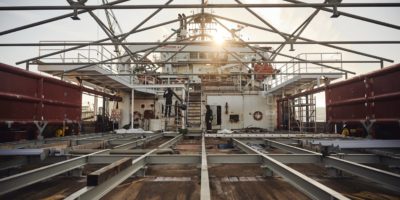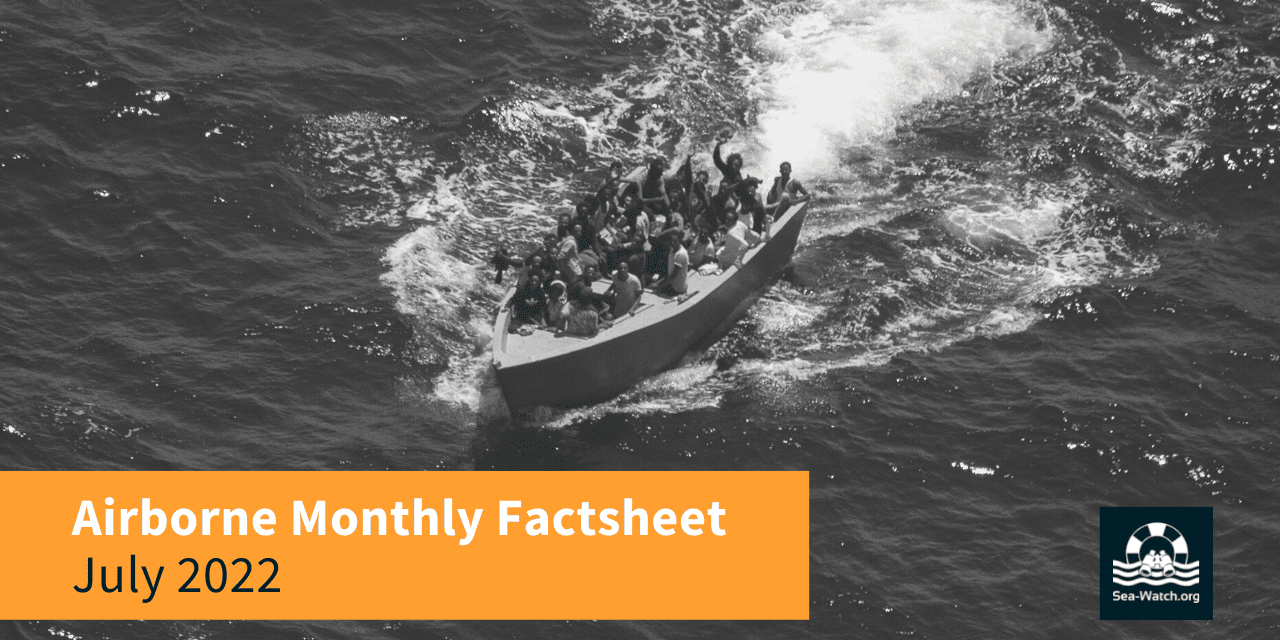This factsheet presents a summary of the distress cases witnessed in July 2022 by Sea-Watch’s Airborne Operations with the aircraft Seabird 1.(1) In July 2022 we flew in the Maltese Search-and-Rescue (SAR) zone only, conducting 17 operations over a total flight time of 88 hours and 50 minutes. We spotted 42 boats, carrying around 1,698 persons in distress. (2) Unfortunately, due to the illegal restrictions put into place by the Libyan Civil Aviation Authority(3), Airborne was not permitted to monitor the Libyan Search-and-Rescue (SAR) zone and the human rights violations occurring there.
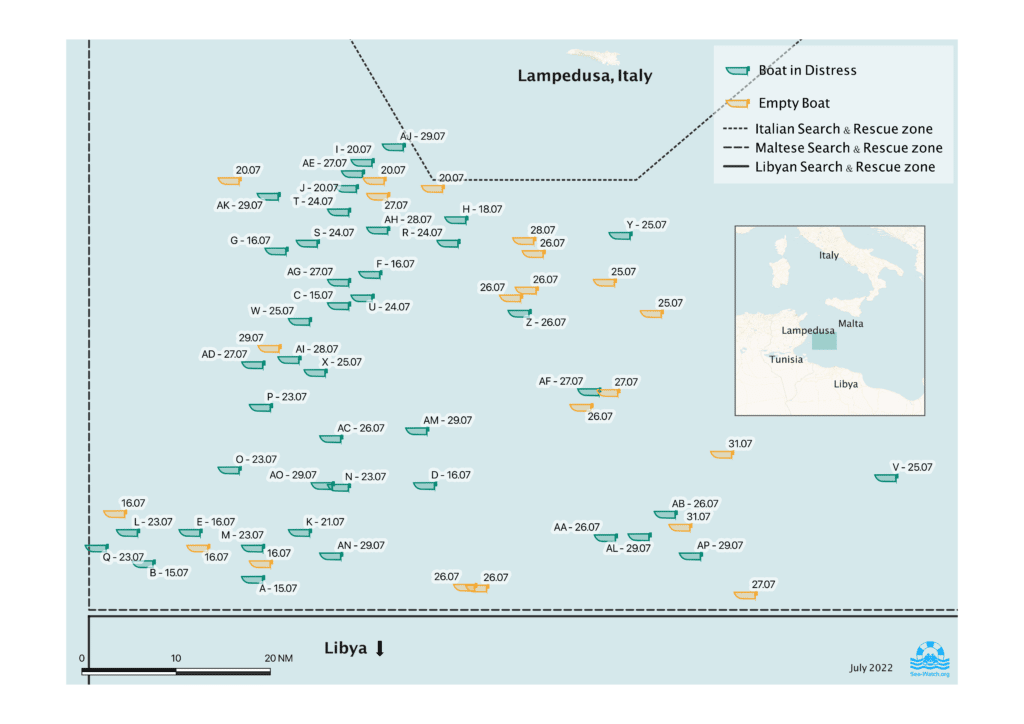
Overview of boats in distress and empty boats spotted
Maltese Search-and-Rescue (SAR) Zone
2 boats in distress, around 80 persons, were intercepted by the so-called Libyan Coast Guard in the Maltese SAR zone and pulled back to Libya
26 boats, around 1,314 persons, were rescued by the Italian authorities or arrived independently in Lampedusa, Italy
2 boats, 77 persons, were rescued by the NGO vessel Geo Barents(4) and disembarked in Taranto, Italy
1 boat, 12 persons, was likely intercepted and pulled back to Tunisia by the Tunisian Coast Guard
The outcomes for 11 boats, with around 215 persons, remain unknown
Details and outcomes for boats in distress and empty boats
16.07.: Lack of English speaking personnel and unavailability of the Libyan authorities. On 16.07., Airborne‘s ground crew tried to call the Libyan authorities on 2 occasions. The first time, out of 5 numbers called, on 3 occasions there was no answer or the number did not work. An exchange was not possible with 2 other numbers due to the lack of English spoken by the Libyan personnel. Later, the second time Airborne‘s ground crew called the Libyan authorities, the person on the phone provided a position and a time, stating that he had received the position but that the boat was “in Tunisian waters” and therefore outside of the so-called Libyan Coast Guard‘s authority. The position however was in the Libyan Search-and-Rescue (SAR) zone.
16.07., distress case E, 12 persons: Illegal pullback to Tunisia, Tunisia is not a place of safety. On 16.07. in the late afternoon, Seabird 1‘s crew sighted a boat carrying 12 persons in the Maltese SAR zone. The initiative Watch the Med – Alarm Phone had been called by persons on the boat and had informed the authorities – where due to the position of the boat and the number of persons, the cases could be matched. According to testimonies from survivors later provided to the initiative Watch the Med – Alarm Phone, the people were ultimately intercepted and pulled back to Tunisia by the Tunisian Coast Guard.
Tunisia cannot be considered as a place of safety for people rescued at sea, as defined by the International Maritime Organization’s Resolution MSC. 167(78). Firstly, there exists no domestic asylum system in Tunisia – meaning that asylum-seekers are left without legal protection. Persons on the move are arbitrarily detained, since unauthorised entry and stay are criminalized, where the legal framework related to detention remains unclear.(5) Furthermore, Tunisia has previously conducted several chain-refoulements to other states, including Libya(6) – meaning that there is a risk that persons on the move are brought to other unsafe countries. Finally, people on the move, but also other persons affected by discrimination and criminalization, in particular LGBTQI* persons, can in Tunisia be subjected to human rights violations.(7)
20.07., distress case J, 20 persons: Overheard communications, Frontex involved, Maltese authorities refusing to cooperate, rescue operation to Lampedusa. Seabird 1’s crew overheard a communication on the radio about a boat in distress in the Maltese SAR zone. Based upon open sources monitored by Airborne’s ground crew, Frontex’s aircraft Eagle 1 was presumably on scene more than 1 hour later. Seabird 1’s crew then sighted the persons in the Maltese SAR zone shortly after Frontex. A fishing vessel was in the vicinity and changed course towards the persons. The Maltese Rescue Coordination Centre (RCC) was called by Airborne’s ground crew regarding this incident on 2 occasions: in both calls, the operators said that they would call or talk to the duty officer before hanging up. Shortly afterwards, an Italian Coast Guard patrol boat approached the scene, witnessed by Seabird 1’s crew. The people were rescued and disembarked in Lampedusa, Italy.
21.07., distress case K, 84 persons: 2 days of non-assistance, a merchant vessel standing by without rescuing, Frontex involved. On 20.07., the people in distress called the initiative Watch the Med – Alarm Phone, which immediately informed the authorities and NGOs in the area. Monitoring open sources, in the early morning on 21.07. Airborne’s ground crew then observed Frontex’s aircraft Osprey 3 orbiting in a position fitting with the boat’s likely track. Later in the afternoon, Seabird 1’s crew sighted the persons in the Maltese SAR zone. The Maltese authorities were called twice by Airborne’s ground crew but did not answer the phone, although it is their duty according to international law to be available on a 24 hour basis. The merchant vessel Victoria, flying the Italian flag, was in the vicinity of the people in distress and changed course towards their position. The shipmaster requested instructions from the Maltese and Italian RCCs and the port authorities of Lampedusa, however without being ordered to rescue the persons in distress. In the evening, Airborne’s ground crew again tried to call the Maltese authorities on 2 occasions. The first time, the operator said that he would inform us about the situation but did not. In the second call, the operator said that he would inform the duty officer and hung up. On 22.07., the Maltese authorities told Airborne’s ground crew that the people had been rescued but that they did not know by whom, and also that the Maltese authorities were not coordinating the case since “the case is not a distress case”. The boat was an overloaded and unseaworthy rubber boat, where the people were not wearing any life vests: it is unquestionable that the people were in distress. The people were rescued on 22.07. by the Italian authorities and disembarked in Lampedusa.
On 23.07, Seabird 1’s crew sighted 6 boats in distress, carrying around 120 persons. The outcomes for all of these boats remain unknown.
24.07., distress case S, 45 persons: A merchant vessel leaving a distress case unattended, no support received by authorities delaying the rendering of assistance to the boat in distress. On the morning of 24.07., the Initiative Watch the Med – Alarm Phone was called by approximately 45 persons in distress and informed the authorities as well as civil actors operational in the area. Seabird 1’s crew later spotted the boat and forwarded an updated position to the authorities. The merchant vessel Marietje Marsilla, flying the Dutch flag, was close-by and was therefore also alerted to the distress case by Seabird 1’s crew. After some time, the merchant ship changed course towards the people in distress. Despite the boat being stationary, presumably because it had run out of fuel, and with 45 persons on board making the vessel clearly overcrowded, the Marietje Marsilla did not consider the boat as a distress case and left the scene after not receiving instructions by authorities. The initiative Watch the Med – Alarm Phone was continuously in contact with the people in distress and sent updated positions to the authorities. In the end, the persons were rescued by the Italian Coast Guard on the 25.07. and disembarked in Lampedusa, Italy.
On 26.07., distress cases AA and AB, with respectively around 50 and 30 persons: The so-called Libyan Coast Guard intercepting 4 boats within the Maltese SAR zone, use of a previously intercepted boat for the interception of another, Frontex aircraft involved. Around noon on 26.07., Seabird 1’s crew spotted the so-called Libyan Coast Guard patrol boat Fezzan with around 50 intercepted people on its deck, towing an empty wooden boat. Another empty wooden boat was driving at the same speed alongside Fezzan with 2 persons on board steering, most likely officers of the so-called Libyan Coast Guard. Two hours later, in the early afternoon, Seabird 1‘s crew spotted the aftermath of a further interception (AA) of approximately 50 persons by the patrol boat Fezzan. Immediately afterwards, Fezzan approached another boat in distress (AB) which was only 7 nautical miles(8) away. Until Fezzan arrived on the scene, the boat (AB) was taken alongside a wooden boat from which the people were then transferred to the so-called Libyan Coast Guard vessel. It turned out that the wooden boat that supported this interception of case AB was in fact the empty boat spotted at noon. The so-called Libyan Coast Guard thus used an intercepted boat for the interception of another boat in distress.
The Frontex aircraft Osprey2 was on this day orbiting in a position that could match with an earlier position of distress case AA. Due to the proximity of the boats AA and AB, it is likely that Osprey was also aware of the second boat. We have to assume that Frontex again facilitated at least 1 pullback by the so-called Libyan Coast Guard from the Maltese SAR zone.
25. and 28.07., distress cases V and AI, 52 persons and 25 persons: Civil actors again filling the state-created rescue gap in the Central Mediterranean, situation on board worseningand becoming critical due to the delayed allocation of a safe port. On 25.07., the initiative Watch the Med – Alarm Phone was contacted by 52 persons on board a boat in distress (V) and informed both the authorities and NGO vessels in the area. The NGO vessel Geo Barents acknowledged the distress call and changed course towards the given position. Seabird 1’s crewspotted the boat several times, forwarding the updated positions to all actors and reporting that the boat’s engine was functioning erratically. The Geo Barents finally arrived on scene and safely embarked all persons.
On 28.07., the initiative Watch the Med – Alarm Phone was contacted by people in distress (AI), informing both the authorities and civil actors in the area. Seabird 1’s crew later spotted the boat and updated all relevant actors about its position. At that time, the boat was no longer able to move. The NGO vessel Geo Barents changed course towards the last known position of the boat and ultimately conducted a rescue operation of 25 persons.
The NGO vessel Geo Barents rescued a total of 659 persons in 11 different rescue operations. However, due to the delayed allocation of a port of safety by the responsible authorities, the people on board had to wait 9 days until their eventual disembarkation in Taranto on 05./06.08.2022.
On 29.07., Seabird 1’s crew sighted 7 boats in distress, carrying around 358 persons. All of these boats were presumably rescued by the Italian authorities and disembarked in Lampedusa, Italy.
29.07., distress case AL, 122 persons: Authorities aware of a larger wooden boat in distress but only conducting a rescue close to the shores of Lampedusa, hence risking the lives of the persons in distress. On the afternoon of 29.07., Seabird 1’s crew spotted a wooden boat in distress and informed both the authorities and NGO vessels in the area. Later, the boat could be matched with a distress call received by the initiative Watch the Med – Alarm Phone. The sailing vessel Nadir(9) changed course towards the last known position and found the 122 persons in distress during the evening. Since the sailing vessel’s capacities are limited, the crew was not able to embark the people in distress but instead monitored and stabilized the situation and accompanied the persons towards Lampedusa. The Italian Coast Guard conducted a rescue operation only a few nautical miles south of Lampedusa in the early morning of the 30.07., finally bringing the people ashore to Lampedusa.
In July 2022, with the aircraft Eagle 1, Osprey 2 and Osprey 3, we must assume that the European Coast Guard Agency Frontex was involved in the narratives of at least 7 boats in distress, concerning around 376 persons, sighted by Seabird 1’s crews in the Maltese SAR zone. 6 of these boats were rescued by the Italian authorities or likely arrived independently in Lampedusa, Italy. At least 1 boat was intercepted by the so-called Libyan Coast Guard in the Maltese (!) SAR zone and pulled back to Libya.
In July 2022, the air crews also overheard communications regarding 7 possible boats in distress over the radio that were not sighted by Seabird 1.
In July 2022, Seabird 1’s crews spotted 21 empty boats. According to their markings, 3 empty boats are believed to be the remnants of rescue operations conducted by the Italian authorities. 2 empty boats are the remains of interceptions conducted by the so-called Libyan Coast Guard. The outcomes for 16 boats remain unknown.
These operations highlight once again:
- the deadly consequences of European migration and border policies
- the systematic non-assistance by European Member States and their delegation of rescue operations to the so-called Libyan Coast Guard, even from the Maltese SAR zone
- the participation of Frontex in interceptions and pullbacks undertaken by the so-called Libyan Coast Guard
- the continuous involvement of merchant vessels with boats in distress at sea due to a failed migration politics in Europe
- the unjustified and systematic delays by European Member States in fulfilling their obligations to conduct and coordinate sea rescue in their Search-and-Rescue zones
- the need for NGO vessels in the Central Mediterranean Sea in order to uphold the law and save human lives
(1) Since 2017, together with the Swiss NGO Humanitarian Pilots Initiative, Sea-Watch monitors the Central Mediterranean Sea, currently with its aircraft Seabird 1 and Seabird 2.
(2) These numbers are based upon the estimations of Seabird 1’s crews as well as numbers which the initiatives Watch The Med – Alarm Phone and Mediterranean Hope-FCEI have provided to us.
(3) Since the beginning of March, the Libyan authorities illegally deny entry to the Libyan Flight Information Region (FIR) for our airplanes Seabird 1 and Seabird 2. See Airborne Monthly Factsheet for the months of February and March 2022, and https://twitter.com/seawatch_intl/status/1545699184447307776.
(4) The Geo Barents is operated by the NGO Médecins Sans Frontières.
(5) See Global Detention Project, 2020: https://www.globaldetentionproject.org/immigration-detention-tunisia-shrouded-in-secrecy ; Heinrich Böll Stiftung Brussels, 2020: https://tn.boell.org/sites/default/files/2020-09/Places of safety Dig.pdf
(6) OHCHR, 2021: https://www.ohchr.org/en/press-releases/2021/11/tunisia-and-libya-un-experts-condemn-collective-expulsion-and-deplorable
(7) Heinrich Böll Stiftung Brussels, 2020: https://tn.boell.org/sites/default/files/2020-09/Places of safety Dig.pdf
(8) Nautical Miles is the unit of measurement used at sea. 1 nautical mile is equal to 1,852 kilometers.
(9) The sailing vessel Nadir is operated by the NGO RESQSHIP.

